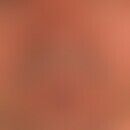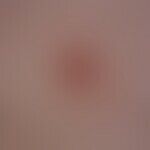Synonym(s)
DefinitionThis section has been translated automatically.
Benign, biphasic (epithelial-conjunctival), dermal or subcutaneous, solitary but also multiple tumor with follicular germ cell differentiation. They occur as the most frequent secondary neoplasia in the nevus sebaceus.
ClassificationThis section has been translated automatically.
According to the currently valid WHO classification, different histological variants of trichoblastoma are distinguished:
- Large-boned
- Small Nodules (including adamantinoid)
- Retiform (solitary giant trichoepithelioma) - very rare variant
- Cribriform (conventional trichoepithelioma) - most common variant
- Razemiform (non-conventional trichepithelioma)
- Columnar (desmoplastic trichoblastoma)
You might also be interested in
ManifestationThis section has been translated automatically.
Occurring at any age. Preference for the 5th to 6th decade of life. The sporadic tumours are predominantly of the female sex (2-5:1).
LocalizationThis section has been translated automatically.
ClinicThis section has been translated automatically.
Solitary or multiple, skin-coloured, pigmented, also reddish, firm, 0.5-3.0 cm large, surface-smooth, clinically otherwise completely uncharacteristic nodule. Larger lesions are rather rare.
The diagnosis is usually a histological incidental finding.
Especially the large nodular variant of the trichoblastoma (this finding is probably identical with the "giant trichepithelioma or solitary giant trichoepithelioma") is found as secondary tumor in nevus sebaceus.
HistologyThis section has been translated automatically.
Differential diagnosisThis section has been translated automatically.
TherapyThis section has been translated automatically.
Progression/forecastThis section has been translated automatically.
Usually benign tumor of the germ cells of the hair follicle, although aggressive, infiltrative growth is repeatedly described; malignant degeneration may also occur. Excision in sano with incision margin control is recommended. Local recurrence is rare.
Note(s)This section has been translated automatically.
LiteratureThis section has been translated automatically.
- Ackerman AB, De Viragh PA, Chongchitnant (1993) Trichoblastoma. In Ackerman AB: (eds) Neoplasms with follicular differentiation. Lea & Febiger, Philadelphia London, pp. 359-422.
- Imai et al (1982) Trichogenic trichoblastoma. Dermatologist 33: 609-611
- Kaddu S et al (2003) Adnexal tumors with hair follicle differentiation. In: Kerl H et alo. (Eds) Histopathology of the skin. Springer, Berlin Heidelberg New York pp 662-664.
- LeBoit PE (2003) Trichoblastoma, basal cell carcinoma, and follicular differentiation: what should we trust? Am J Dermatopathol 25: 260-263
- Misago N et al (2002) Sebaceoma and related neoplasms with sebaceous differentiation: a clinicopathologic study of 30 cases. Am J Dermatopathol 24: 294-304.
- Requena C et al (2019) Multiple facial plaque variant of trichoblastoma. J Cutan Pathol 46: 285-289.
- Walke r B et al. (2021) Invasive Trichoblastoma Treated With Mohs Micrographic Surgery. Dermatologic Surgery: 47: 1275-1276.
- Cowen EW et al (2000) An unusually aggressive trichoblastoma. J Am Acad Dermatol. 42:374-377.
- Demant M et al (2020) Don't Judge a Tumor by Its Biopsy! Case Rep Dermatol 12: 266-274
Incoming links (10)
Dystrophia myotonica; Fibroma trichoblastic; Fibroma trichogenic; Myxoma, trichogenic; Panfolliculoma; Premalignant fibroepithelioma; Spiradenoma; Trichoblastoma adamantinoides; Trichoepithelioma, immature; Trichogenic adnexal tumor;Outgoing links (6)
Adenoma sebaceum; Basal cell carcinoma (overview); Excision; Multiple Trichoepithelioma ; Nevus sebaceus; Trichofolliculoma;Disclaimer
Please ask your physician for a reliable diagnosis. This website is only meant as a reference.







